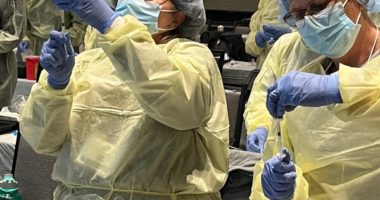 Spring is starting to morph into summer, but this one is unlike any that most of us have ever seen, given the lingering effects of the COVID-19 pandemic and the unclear future sequence of events. By now, everyone should have received their May copy of the Annals and hopefully had time to look it over. This month has many important features for the practicing allergist-immunologist, and I hope you will take time to read and ponder as many as you can. Toward that goal, I have a couple of suggestions.
Spring is starting to morph into summer, but this one is unlike any that most of us have ever seen, given the lingering effects of the COVID-19 pandemic and the unclear future sequence of events. By now, everyone should have received their May copy of the Annals and hopefully had time to look it over. This month has many important features for the practicing allergist-immunologist, and I hope you will take time to read and ponder as many as you can. Toward that goal, I have a couple of suggestions.
This month’s emphasis in on food allergy. A review article by Paul Turner, PhD, FRACP and his group from London tackles the challenges of identifying phenotypic profiles for food allergic patients. Data are emerging to confirm our clinical experience that many food-allergic patients experience predictable symptoms following food allergen exposure, both in the community and at supervised oral food challenges. The data show these symptoms vary in severity and presentation between individual patients. Integrating datasets from different cohorts and applying unbiased machine-learning analyses may demonstrate specific food allergy endotypes in a similar way to asthma with the ultimate intent to improve patient management (e.g. risk stratification, prescribing EAI, etc.).
Another review in this month’s issue addresses reactions to foods during avoidance strategies with an emphasis on peanuts written by Peter Capucilli, MD, and colleagues. Peanut allergy has historically been difficult to manage, with most cases persisting into adulthood. Novel therapies for peanut allergy treatment are on the horizon, yet allergists must maintain a robust understanding of the risks and benefits of the current standard of therapy: avoidance diet. Clinicians should continue to discuss avoidance as a viable option for long-term peanut allergy management and empower patients to differentiate relevant situations in which accidental reactions might occur.
Another feature that we periodically publish is a Pro-Con debate. This month, we feature a discussion about the utility of fresh food as a reagent for skin prick testing in the diagnostic paradigm for food allergy. Arnon Elizur, MD, and Michael R. Goldberg, MD from Tel Aviv present the “pro” side, commenting on the limitations of commercial food extracts as SPT reagents and the added value of fresh foods as testing reagents. Aikaterini Anagnoastou, MD, PhD, FACAAI, from Houston counters with a “con” perspective in which she argues issues related to safety (including increased anaphylaxis risk) and reliability of the results for multiple different reasons. This topic is of considerable practical value to practicing allergists-immunologists, and these two extremely well written perspectives will be thought provoking, I promise you.
I hope all of you are starting to return (or at least have identified a path to return) back toward a normal life, both personally and professionally. We remain committed to providing the highest quality journal that can possibly be produced. We will continue to need your help to maintain and improve Annals. Thank you to all who have volunteered, and continue to volunteer, to review manuscripts and those who continue to contribute as authors. See you next month.
Gailen D. Marshall, Jr., MD PhD FACAAI
Editor-in-chief

